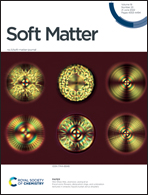Tunable two-step shape and dimensional changes with temperature of a PNIPAM/CNC hydrogel†
Abstract
PNIPAM (poly(N-isopropylacrylamide)), a well-studied thermo-responsive polymer, undergoes conformational transition around 32 °C. On the other hand, cellulose nanocrystals (CNCs), as a promising and biocompatible material, has rarely been introduced to the PNIPAM-based fibrous hydrogel system. CNCs’ impact on the temperature responsive behaviors of hydrogels, either in single layer or bilayer hydrogel systems, is yet to be investigated. In this work, stable well dispersed PNIPAM/CNC suspensions (with various CNC proportions) are prepared and electrospun into nanofiber membranes. The corresponding hydrogels are then obtained via UV-induced crosslinking. CNCs are found to exert a significant constraint effect on hydrogel swelling when it exceeded 5 wt% but a negligible effect on contraction. The difference between hydrogels with various CNC proportions regarding their temperature responsive behaviors is utilized to fabricate bilayer hydrogels. These bilayer samples are capable of generating 3D geometries when they come into contact with water for the first time via anisotropic swelling between the two layers and changing their dimension reversibly in the following swelling and contraction. In addition, these geometries are found to be highly tunable via the finely tuned thickness ratio between the two layers. This promising feature would significantly extend the application of these materials in tissue engineering where a controllable geometry of the culture substrate is of great importance.



 Please wait while we load your content...
Please wait while we load your content...